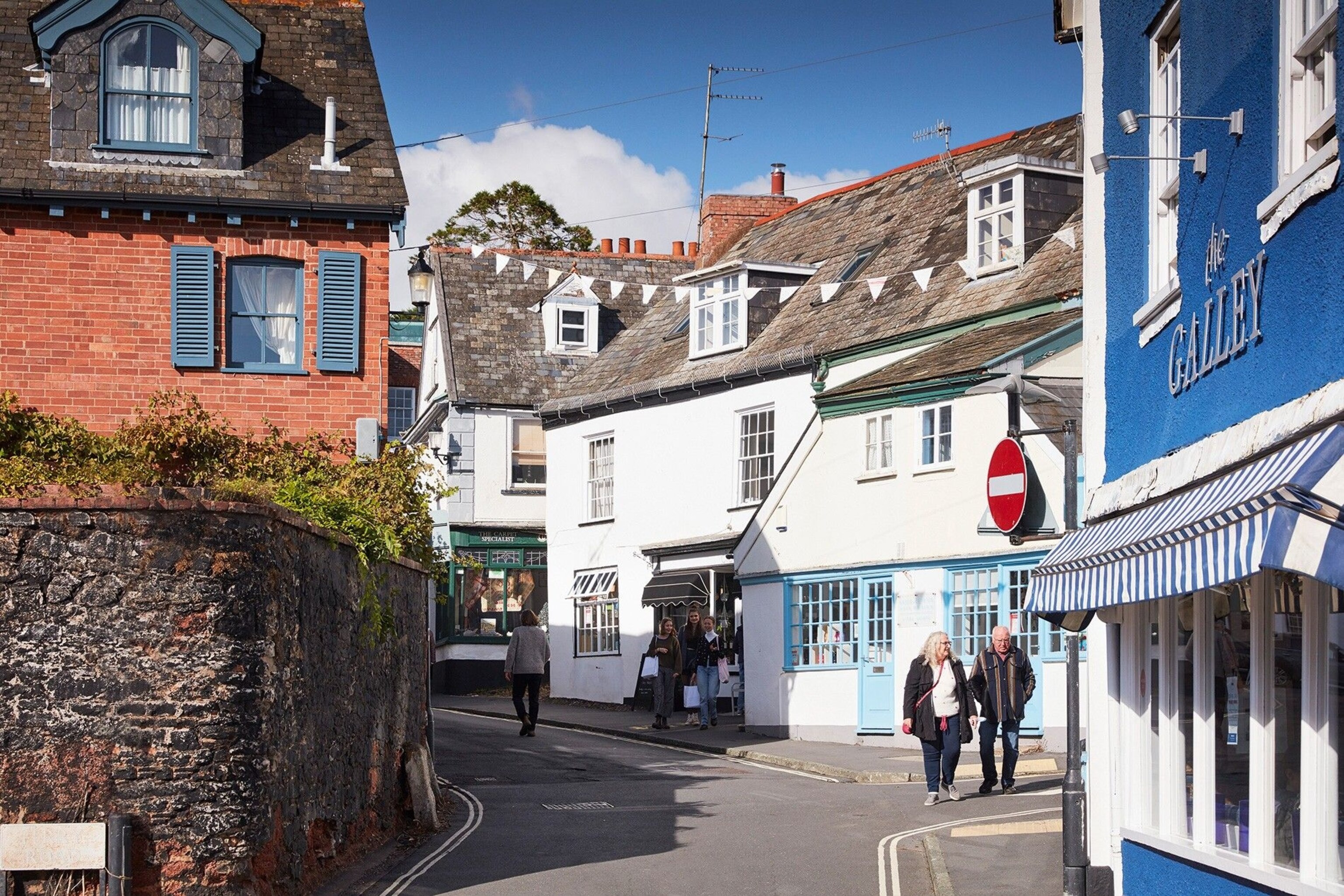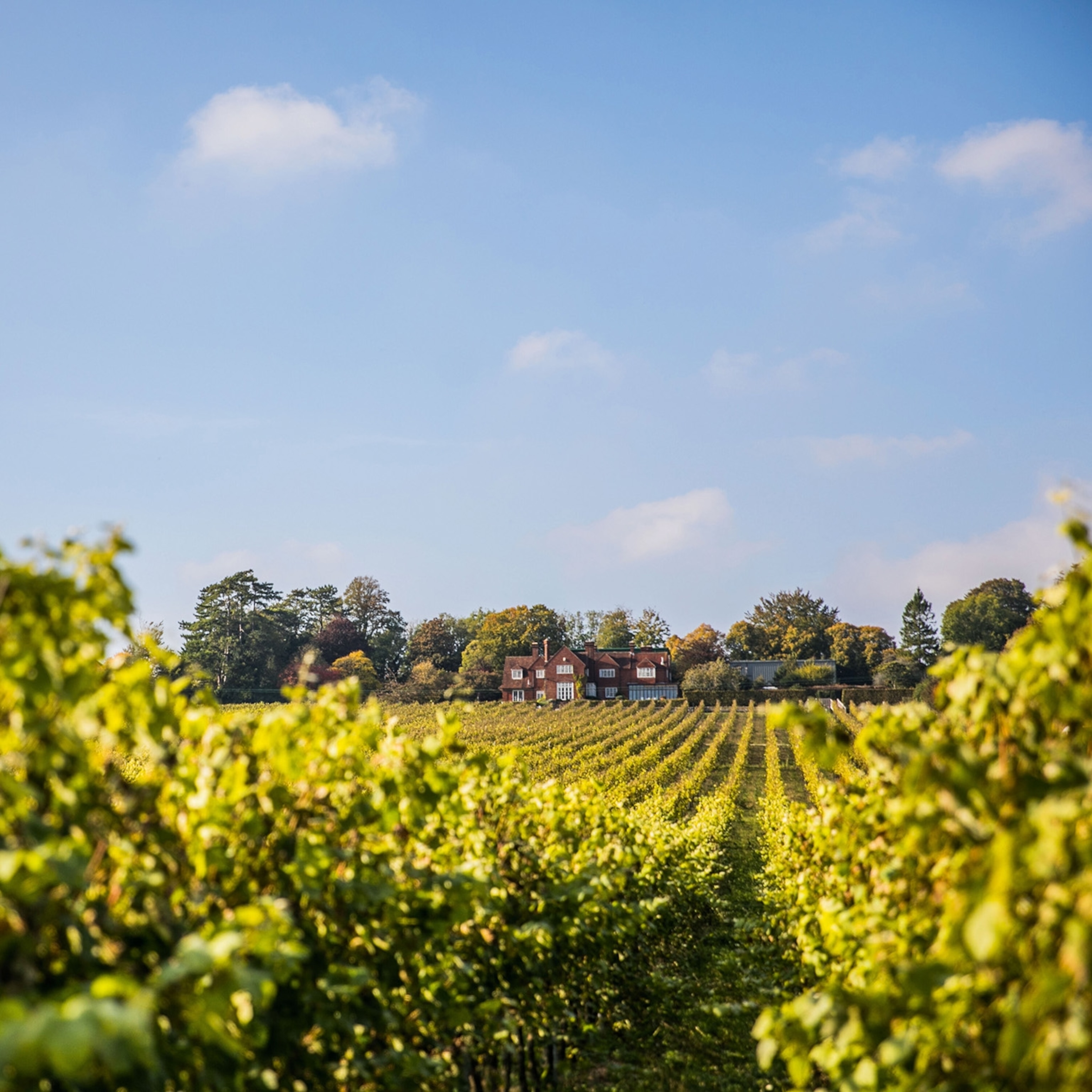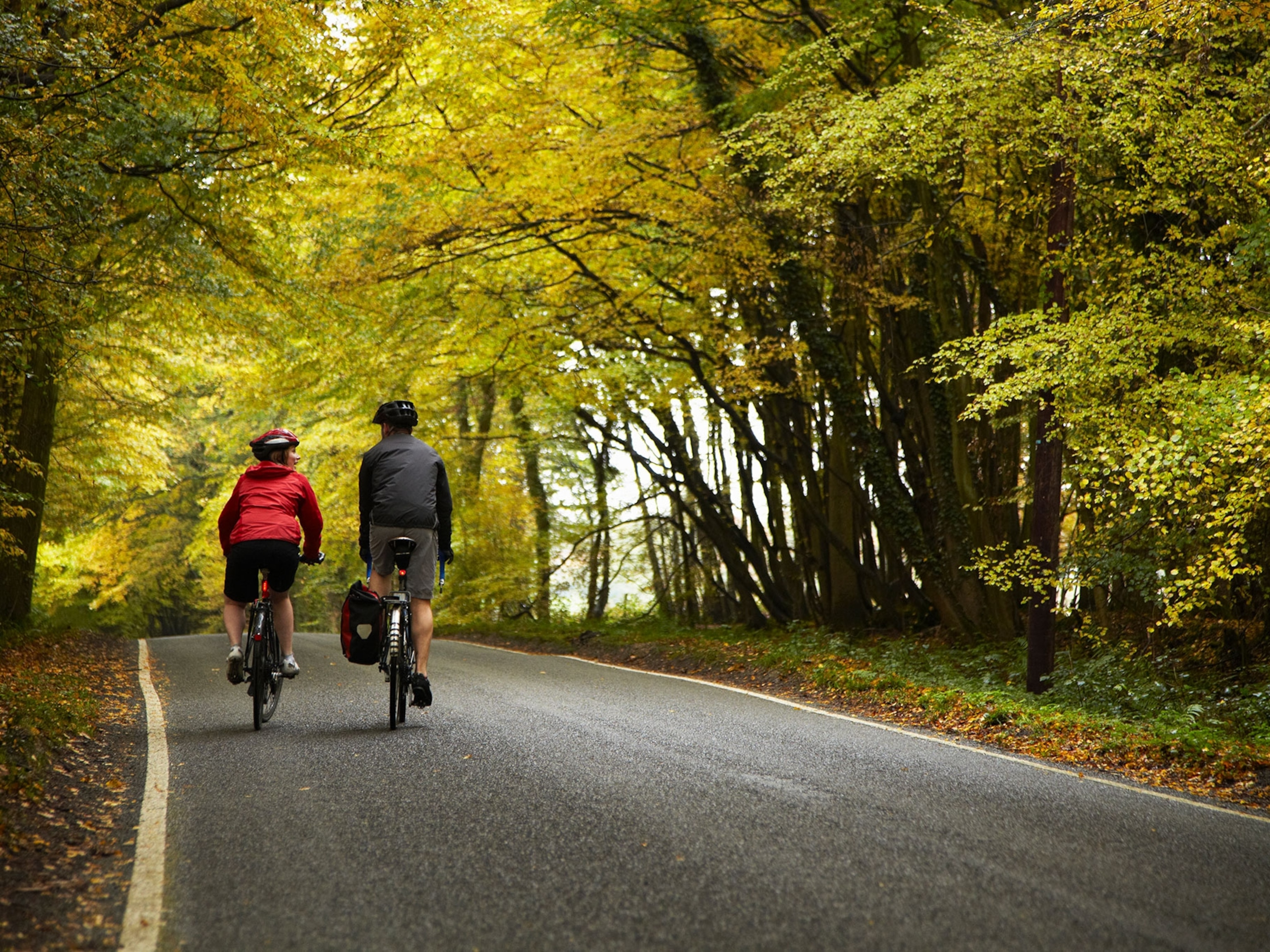
Pirates and prehistory on Devon's southeast coast
Modern-day cheesemakers, distillers and vintners may call Devon’s southeast coast home but the story of these shores stretches back millennia. Ramble along wildlife-rich bays to discover tales of smugglers, Roman ruins and well-preserved fossils.
From a remote, sandstone ledge drops a bewildered man in a wetsuit. It’s taken an eternity for him to jump, and he plummets through the air with an expression somewhere between elation and terror. The rocks zooming past behind him are tens of millions of years old; the bay he’s arrowing into has witnessed visitors ranging from plesiosaurs to pirates. And, with the sun illuminating the red cliffs and ivied, coastal woodland, there comes an almighty splash as the October-cold sea rushes up to swallow him. For the man — who happens to be me — it’s an unutterable thrill.
Tom Devey, the guide who’s just patiently coaxed me into stepping off a 26ft precipice, gives a thumbs-up from the shore and gestures to a cove nearby. We’ve spent the past hour clambering over — and leaping from — the boulders and sea stacks of Devon’s southeastern coastline and it’s now time for a break.
“I’ve got hot chocolate,” he grins, patting his pack and leading us to a tiny beach walled off by giant shelves of rock. As he pours from the thermos, he points out the storage holes and camping spots favoured by generations of smugglers who used this shoreline to spirit illicit shipments of liquor and tobacco into the West Country. “On the subject,” he says, producing a hip flask. “Tot of rum in that?”
On Devon’s southeast coast, the history is spread as thickly as clotted cream. I’m here to discover more about the area’s past and present — feet first, in the case of this coasteering trip near the hill-hidden hamlet of Maidencombe — on a journey from the ancient city of Exeter to the Jurassic Coast, via the pub-dotted ports of the Exe Estuary.

Before then, Tom — who works for Rock Solid Coasteering — leads me through some further jumps. We swim under natural arches and climb rocks, then plunge, drink-warmed, back into the sea. At one point, a grey seal appears, bobbing in the swell just feet away. Tom tells a tale of three bootleggers blockaded into a sea cave by the authorities. “They were trying to drown them,” he explains, as we look east along a series of hefty headlands. “But when they unsealed it three days later, there was no sign of the bodies. People think the men found a way into the wider cave system and escaped inland.”
The busy quays and taverns of Exeter, 15 miles to the north at the head of the estuary, would’ve been the obvious place to flee. Devon’s county town was no stranger to smugglers and seafarers during the 17th and 18th centuries, and they were far from the first to flock there. Long before, its plum location had attracted Roman and Norman invaders, and, in between their arrival, Saxon settlers.
“Some say that when the Normans turned up, the medieval bishop of Exeter stood on the town gate, bared his bottom and farted at William the Conqueror!” says David Radstone, one of the city’s Red Coat guides, with palpable relish. I meet him on Cathedral Green for a free city tour, in the shadow of the one of the mightiest religious buildings in England. The streets around us are filled with a mixture of timbered, medieval buildings and harsher, post-war architecture. Gargoyles and grotesques glower down from the cathedral guttering.
Home to a large university, the city is fascinating. In the centuries since the Normans arrived, David explains, Exeter has taken on various guises, from prosperous merchant city and hub of the UK cloth trade (in 1700, 80% of Exeter’s residents were employed in the wool industry) to ill-fated Luftwaffe target during the Baedeker Raids, during which 1,500 homes were destroyed in a single night in May 1942.

As we wander the centre, David ties together the strands of the city’s past. We run our hands over the original Roman city walls, stand under imposing Georgian townhouses and stand agog in front of before-and-after photos of the bomb-damaged city. In the distance, green hills bulge into view. “It’s an easy city to live in — 70,000 locals; 25,000 students. You can see the countryside from almost anywhere,” says David.
We end up at the handsome quay, once abuzz with ships and hundredweights of yarn. Today, its old tunnels and warehouses house pizza restaurants, vintage stores and bike-hire outlets. “It has a life again,” enthuses the server at The Coffee Cellar, preparing a latte. He points to a building across the water. “That was once the tram substation. It’s now an indoor climbing centre.”
Away from the quay, among Exeter’s respectable cluster of notable attractions, the Royal Albert Memorial Museum & Art Gallery is fantastic. I’m particularly wowed by a hoard of 22,888 Roman coins found by a local metal detectorist, and the 100,000-year-old hippo fossils pulled from the River Exe. The soaring cathedral, meanwhile — largely unscathed by German air raids — very much lives up to the hype. At 8.15am, I walk self-consciously into morning prayers to find the dean leading a congregation of just two. High above the nave, the world’s largest stretch of uninterrupted gothic vaulting fans out like a giant forest canopy. I find the psalms impenetrable, but am transported, nonetheless.
If there’s a sight that sums up the city’s adaptability, however, it’s The House That Moved. The three-storey medieval building, which looks wonky enough to topple over at any moment, was jacked onto wheels in the 1960s and transported 230ft down the road to its current location on West Street, near the quay, to avoid demolition. That’s southeast Devon; spend time here and you eventually get drawn towards the coast.

Sustainable spirits
“People say it makes sense to make rum in Devon,” says Gemma Wakeham, part of Two Drifters’ wife-and-husband team. The world’s first carbon-negative rum distillery, just outside Exeter is stocked with stills and barrels that recall the coast’s spirit smuggling past. Strung from the rafters, a flag bearing the St Petroc’s Cross, the county emblem: a black-and-white cross on a green background. That’s more or less where tradition ends.
“The whole distillery is electric and runs on renewable energy,” says Gemma, explaining how husband Russ’s background in chemistry has driven their green ethos. They use the same carbon capture technology recently adopted by Coldplay for its pioneering net-zero tour; Chris Martin, incidentally, is a former Exeter Cathedral choirboy and were recently approached to supply cocktails for the COP26 UN Climate Change Conference. The rums themselves taste great, full of woozy zest and warmth. “When we launched in 2019, we were producing 80 bottles a week,” says Gemma. “That’s now 2,500.”
The distillery aims to offset every single element of its production, from the growing of spices to the shipping of sugar cane. This is in my mind as I head along the Exe Estuary to Topsham, once the second-busiest port in England. I arrive to the sound of baying gulls and mast-slapping halyards, with the river shimmering out towards the sea, surrounded by saltmarshes.

“When William of Orange arrived in England in 1688 to take the throne, this is where his fleet arrived,” says Ed Williams-Hawkes, a powerboat navigator — complete with eye patch — who moved to Topsham in the 1960s. He points towards the quay. “You can imagine the scene; Turkish cannons being pulled by shire horses; platoons of Swiss guards; Norsemen in white bearskins. Incredible to think about.”
Ed’s son Tom is head chef at The Salutation Inn, a few minutes’ walk away, past Dutch-gabled townhouses. Like the rest of the town, the inn creaks history. Its 300-year-old wooden door — broad enough for Victorian coaches to pass through — is still marked with apotropaic carvings (to ward off evil spirits). These apparently didn’t stop some lively activities taking place here in centuries gone by, from attempting to get a horse to jump over a table in the dining room to public wrestling matches.
It’s a lot less rowdy on my visit, largely because the inn is now geared towards one of the region’s more enduring joys: good food and drink. The restaurant prides itself on serving local produce such as crab, partridge and West Country cheeses; an in-house fish deli, opened during lockdown to support local fishermen, is still going strong.
Tom was trained by another Exeter local, Michael Caines, who’s perhaps done more than anyone to draw attention to Devon’s culinary scene. One of the few Black chefs in the UK to have earned a Michelin star, he opened five-star Lympstone Manor in 2017. The Grade II-listed country house gazes out across the Exe Estuary a few miles south of Topsham and is home to the kind of luxury hotel-restaurant where discreet tags tell you how expensive the artworks are, and where, on arrival, you sense time itself begin to slow down, brush its lapels, and loosen its belt a notch.

The view from the manor’s 28-acre grounds is a spectacular one: a sun-dappled horizon of rumpled green, shot through by the silvery swathe of the estuary. In the foreground sits the hotel’s own vineyard, a nursery for English sparkling wines. Its neat rows of vines are visible from the window when I’m led through for afternoon tea. It’s the works: a choice of 10 different teas and infusions, a small army of staff in ironed aprons, and a three-level cake stand stacked with pastries, scones (don’t dare go jam first — this is Devon) and finger sandwiches. The octogenarian ladies at the next table are jubilant when theirs is placed in front of them. “I can’t see you now!” says one to the other.
But no matter how delicately baked the fig tarts are, it’s hard to top the grounds. On a crisp autumn day, the sight of the estuary is a hypnotic one: a silky expanse of land and water under a colossal, South Coast sky. The hotel’s rooms and suites are all named after birds, and for good reason. The marshes and mudflats that stretch between Exeter and the English Channel are a site of international importance for wading birds, who flock here in their tens of thousands to feed on invertebrates.
At nearby RSPB Bowling Green Marsh, I find a seat in the hide overlooking the reed beds. I’m too early for the throng of winter visitors — geese from Siberia, godwits from Scandinavia — but the scene is still a lively one. Pretty teals fuss on the banks, and shovelers dabble past waggling their platypus beaks. Elsewhere in the hide, I can hear a hushed conversation about moorhens. It’s a peaceable spot, and mighty easy to linger in, but looking up I see heavy clouds, rolling in, as relentlessly as waves, from the direction of the open sea.

Folk songs & fossils
“The captain’s in his cabin, boys, drinking rum and brandy — away, haul away, we’ll haul away, Joe!”
It’s Thursday folk night at Exmouth’s The Bicton Inn, mere streets from the sea. Forty voices ring around the pub, surging in unison and fogging the dark windows. Naval ensigns are strung around the walls and tankards are being downed. “This song is about how the news of Nelson’s victory travelled across the land,” announces a well-oiled greybeard, as another local gets his accordion ready. “Although it’s said there are a few north of Tiverton who still haven’t heard.”
The inn was recently named the ‘best community pub in East Devon’ by the Campaign for Real Ale, and a blackboard lists upcoming backgammon sessions, vinyl nights and knitting clubs. Tonight, though, as the rain clouds mass overhead, star billing goes to southeast Devon’s maritime links. The local sailors of the Trafalgar era wouldn’t have witnessed the kitesurfers that busy the headland these days, but the sea air — and the lingering hint of journeys to faraway lands — would’ve been as restorative then as they are now.
“Well, heave her up and away we’ll go,” roars the chorus of voices, “She’s a fast clipper ship and a bully good crew.”

Exmouth is also the official starting point of the 96-mile Jurassic Coast. This UNESCO World Heritage Site is where local history does a few somersaults, kisses goodbye to the human race and speeds away into the mists of time. Although the coast’s name is something of a misnomer; the rocks here actually yawn back as far as the Triassic era; some of those near Exmouth are 250 million years old.
The resulting scenery — all Big Dipper ridges and wild, wave-bashed headlands — makes it a glorious place to hike, dawdle or just simply gawp. The geological timescales are brain-spinning: the red cliffs here were originally part of a vast desert, which was later flooded by a tropical sea. Around 140 million years ago, the waters receded, freeing up more space for roaming dinosaurs, before sea levels rose again 100 million years ago. It’s something to mull over during your pre-breakfast constitutional along the prom.
Fair weather has returned by the time I reach Sidmouth, a little further along the coast, where the resort’s aspic-preserved seaside charms remain strong. Well-heeled holidaymakers — not least a young Queen Victoria — have been coming here for centuries, and elegant, flower-filled hotels still gaze out from the seafront. At sunset, I watch the sandstone bluffs to the west of town glow an incongruous Uluru-orange.
Outwardly, at least, this is still the Devon of bandstands and bathing machines. “It’s in a time warp, but in a good way,” laughs sharply dressed town clerk Chris Holland, a man who’s been part of the local brass band since the age of 11. With the resort is spread out beneath us, he tells me how the pandemic has meant more and more people have been discovering towns along the coast. “It’s a really good thing,” he says. “Somewhere like Sidmouth stays with you.” Chris looks down at the esplanade. “I’ve lived here all my life, and I still need to see the sea each day,” he says. “Just to check it’s still there.”
It’s true that the presence of the sea becomes addictive. On the way home, I decide to stop off in Lyme Regis. It’s a (prehistoric) stone’s throw from Devon itself, but on the basis that geology doesn’t recognise county borders, it feels an apt place to visit. Here, as much as anywhere, the region’s multilayered history is on full show. I walk past a long line of pastel-painted beach huts to reach Lyme Regis Museum, which tells tales of smugglers’ ships, naval brigs and British palaeontologist Mary Anning, portrayed by Kate Winslet in the 2020 film Ammonite.
The museum sits in what was once Anning’s home, and I follow the advice of a staff member to wander out to Black Ven, a nearby undercliff. “Erosion means there are always new fossils being exposed,” she explains. It’s early evening and there are seven others searching the rocks, as a stiff breeze comes in off the sea. After 20 minutes, with the light getting dimmer, I turn a stone and find a partial ammonite imprint the size of my thumb. It’s not the prettiest find — or the most intact — but it represents about 70 million years’ worth of history, and that’ll do me.

Essentials
Getting there & around
London Waterloo and Paddington, Birmingham New Street, Cardiff Central, Penzance and Newcastle all have direct trains to Exeter. The Avocet Line is a useful local rail service from Exeter to Exmouth, with stops including Topsham and Lympstone.
When to go
With its mild maritime climate, Devon is a year-round destination although four seasons can be experienced in one day pretty much any time of year. The Sidmouth Folk Festival is held every summer (29 July to 5 August, 2022). Winter is good for birdwatching on the Exe Estuary.
Where to stay
The Turks Head, Exeter, from £85, room only.
Hotel Riviera, Sidmouth, from £120, B&B.
More info
Slow Travel, East Devon & The Jurassic Coast (Bradt Travel Guides), £14.99.
How to do it
Lympstone Manor offers one night in a double room including breakfast, and an a la carte dinner at its Michael Caines-helmed Michelin-starred restaurant and a complimentary gin tray for £650. Afternoon tea costs an additional £49.50 per person.
Published in the Jan/Feb 2022 issue of National Geographic Traveller (UK)
Follow us on social media
Twitter | Facebook | Instagram







